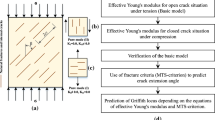Abstract
In this paper, a BEM formulation predicting the reduced mode II and the enhanced mode I stress intensity factors of the mode II test specimen caused by fracture surface roughness is presented. The dilatant boundary conditions (DBC) are based on the assumptions of idealized uniform sawtooth crack surfaces and an effective Coulomb sliding law. They are obtained by relating the crack opening displacement and crack sliding displacement through the assumption of rigid body asperity sliding as in Young (1999). Three different types of crack, i.e. (1) non-interfering flat closed crack; (2) DBC with elastic crack tip; and (3) DBC with plastic crack tip are discussed. The results show a good approximation of the present BEM model. This study also shows the potential application of the present method determining the effect of crack face roughness in a realistic experimental specimen.
Similar content being viewed by others
References
Carlson, R.L. and Beevers, C.J. (1985). A mixed mode fatigue crack closure model. Engineering Fracture Mechanics 22, 651.
Evan, A.G. and Hutchinson, J.W. (1989). Effects of non-planarity on the mixed mode fracture resistance of bimaterial interfaces. Acta Metallurgica 37, 906–916.
Gross, B., Buzzard, R.J. and Brown, W.F. (1986). Elastic analysis of a Mode II fatigue crack test specimen. International Journal of Fracture 31, 151–157.
Gross, T.S., Zhang, Y and Watt, D.W. (1995). Fracture surface interference in shear. Part II: Experimental measurements of crack tip displacement field under Mode II loading in 7075-T6 Al. Acta Metallurgica 43, 901–906.
Patton, F.D. (1966). Multiple mode of shear failure in rock and related materials. Proceedings First Congress of International Society of Rock Mechanics, Lisbon 1, 509.
Tong, J., Yates, J.R. and Brown, M.W. (1995). A model for sliding mode crack closure. Part I: Theory for pure Mode II loading. Engineering Fracture Mechanics 52, 599–611.
Tong, J., Yates, J.R. and Brown, M.W. (1995). A model for sliding mode crack closure. Part II: Mixed Mode I and II loading and application. Engineering Fracture Mechanics 52, 613–623.
Young, L.J. and Tsai, Y.P. (1999). A Boundary Element Application for Mixed Mode Loading Idealized Sawtooth Fracture Surface. International Journal of Solids and Structures 36, 3239–3252.
Author information
Authors and Affiliations
Rights and permissions
About this article
Cite this article
Young, LJ. An analysis of a fracture specimen for rough crack in shear. International Journal of Fracture 115, 273–285 (2002). https://doi.org/10.1023/A:1016363918663
Issue Date:
DOI: https://doi.org/10.1023/A:1016363918663




